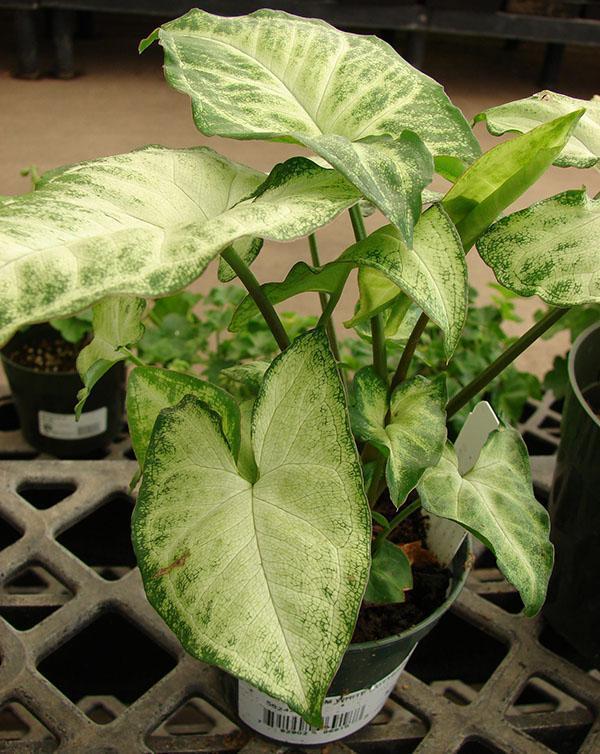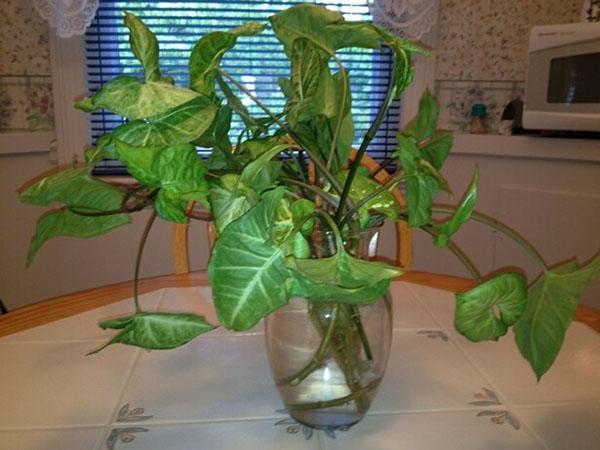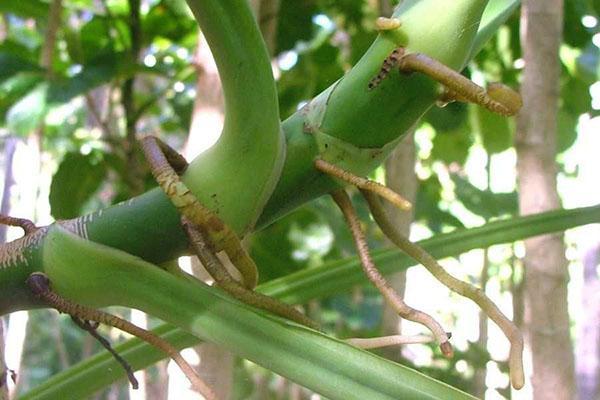Reproduction of syngonium in room conditions, transplantation and possible difficulties
 In nature, syngonium spreads thanks to ripening seeds, as well as vegetatively. But in a pot culture, the plant does not bloom, and the reproduction of syngonium in indoor conditions is carried out using cuttings.
In nature, syngonium spreads thanks to ripening seeds, as well as vegetatively. But in a pot culture, the plant does not bloom, and the reproduction of syngonium in indoor conditions is carried out using cuttings.
How to get and root cuttings correctly? When is it necessary to transplant, and what difficulties can an amateur florist face in growing syngonium?
Even a beginner can grow syngonium. This houseplant is not only one of the most beautiful decorative deciduous vines, but also one of the easiest to use.
Syngonium propagation by cuttings

The main thing is that on each of the cuttings there is at least one node with a kidney sleeping in the bosom. When roots are formed below the node of brownish buds, the bud wakes up and turns into a growth point for a new shoot.
You can prepare and root planting material at any time of the year, but it is best to cut off the shoots in the spring, when the active growing season begins. Winter growth is weaker than spring and summer, the leaves on it are smaller, and the internodes are longer, therefore, stocky cuttings that appeared in spring are taken for reproduction of syngonium in indoor conditions.
 The easiest way to root syngonium is in water, to which an activated carbon tablet is added to prevent rot. At the site of the rudiments of aerial roots, real white rhizomes become visible in a week. When they grow up to 5–7 cm, the cutting is ready for transfer to the ground.
The easiest way to root syngonium is in water, to which an activated carbon tablet is added to prevent rot. At the site of the rudiments of aerial roots, real white rhizomes become visible in a week. When they grow up to 5–7 cm, the cutting is ready for transfer to the ground.
Pruning allows not only to propagate the plant, but also to improve the appearance of an adult syngonium, which begins to branch below the cut point.
If desired, the syngonium can be rooted:
- in a light peat-sand mixture with the addition of crushed sphagnum;
- in washed disinfected sand;
- in vermiculite.
In this case, the seedling must be placed in a greenhouse or covered with a bag together with the pot. The optimum temperature for the formation of its own root system is 22-26 ° C. To prevent condensation from causing rot, the plant must be regularly ventilated and do not forget to maintain soil moisture.
Syngonium transplant
 The first pot for transplanting syngonium should not be large. For one stalk, you can take a container with a diameter of 7-9 cm, but it is better to plant the syngonium in several plants. In this case, the green hat over the pot is especially lush and decorative.
The first pot for transplanting syngonium should not be large. For one stalk, you can take a container with a diameter of 7-9 cm, but it is better to plant the syngonium in several plants. In this case, the green hat over the pot is especially lush and decorative.
When choosing a pot for a transplant, you should give preference to plastic containers, the diameter of which is approximately equal to the depth. There should be a drainage hole at the bottom to drain excess moisture.
Like real epiphytes, syngoniums do not need too much soil. Therefore, if there is already an adult specimen in the house, the appearance of roots from the drainage hole serves as a signal for its transplant.
 Depending on the conditions created for the plant, as well as its type, it is necessary to transfer the green pet to a new pot at intervals of 2-3 years. But young, recently planted specimens of syngonium require transplantation annually. The best time for this is spring:
Depending on the conditions created for the plant, as well as its type, it is necessary to transfer the green pet to a new pot at intervals of 2-3 years. But young, recently planted specimens of syngonium require transplantation annually. The best time for this is spring:
- To prevent the appearance of diseases and pests of the syngonium, a previously prepared loose substrate is disinfected.
- A support is installed at the bottom of the pot, which is sprinkled with expanded clay intended for drainage.
- The drainage layer is covered with moist soil, on which, carefully distributing the roots, the syngonium is placed. If a large plant is transplanted, the old soil is not removed, but the rotten and damaged rhizomes are carefully cut off.
- The gaps between the walls of the pot and the plant are filled with soil, which is carefully compacted and watered.
 After transplanting syngonium, its growth point should remain above the surface of the substrate.
After transplanting syngonium, its growth point should remain above the surface of the substrate.
As a support for the flower, they take ready-made columns based on moss reinforced around the tube. However, an equally reliable structure can be made with your own hands from a piece of plastic pipe and twine.
To make it convenient for the plant to climb up, the surface of the tube is lubricated with moisture-resistant glue, over which a fibrous rope is evenly wound.
Possible difficulties in growing syngonium
 Syngonium is unassuming, very tenacious and does not require vigilant attention from the grower. The most common "problem" that confuses newbies is the appearance of small drops of water on the leaf plates. Don't worry. This is how the plant regulates moisture by draining excess water through the leaves.
Syngonium is unassuming, very tenacious and does not require vigilant attention from the grower. The most common "problem" that confuses newbies is the appearance of small drops of water on the leaf plates. Don't worry. This is how the plant regulates moisture by draining excess water through the leaves.
You need to be wary for other symptoms. For example, syngonium reacts to excessively dry air, lack of irrigation or too high air temperature by drying out the tips of the leaves.
Inhibition of growth, yellowing of foliage and a decrease in its size causes a lack of nutrition in the soil, as well as the stay of the flower in direct sunlight. In the latter case, the leaves not only become smaller, they turn pale, losing their decorative color.
After the plant has been transferred to comfortable conditions, the fertilizing schedule has been normalized or the syngonium has been transplanted, which has "outgrown" the old pot, the situation is getting better.
 It is worse if the difficulties in growing the system are caused by the systematic overflow of the plant. Unfortunately, stem rot and dry brown spots on the leaves are secondary signs preceded by root decay. In this case, it is better to transplant the flower, after removing the damaged rhizomes, and treating the cuts with a powder of charcoal or activated carbon.
It is worse if the difficulties in growing the system are caused by the systematic overflow of the plant. Unfortunately, stem rot and dry brown spots on the leaves are secondary signs preceded by root decay. In this case, it is better to transplant the flower, after removing the damaged rhizomes, and treating the cuts with a powder of charcoal or activated carbon.
Young syngoniums are especially susceptible to putrefactive infections and attack by pests, which, when multiplied in room conditions, immediately took root in the ground. Therefore, it is so important to prevent the formation of condensation inside the greenhouse and to plant cuttings only in a sterile substrate.
Of pests the flower is most often attacked by spider mites, thrips and mealybugs. If the plant is kept in the garden or on the balcony in summer, it is possible that it will become infected with scabbards and aphids. From the greenhouse in which the plant was located before the sale, a whitefly sometimes enters the house. For all these insects, there are effective insecticides and affordable folk remedies, but lasting success can only be achieved with the establishment of constant care for a beautiful indoor culture.
Hello. Help deal with Syngonium disease.
Over the past month, the leaves have begun to turn yellow, and brown spots have begun to appear on them. The first 2 weeks - tore them off - but it did not help.
Watering - once a week. With universal fertilizer - once a month. I spray it every morning. Transplanted - half a year ago in a larger pot.
Help save the plant - I took it by a shoot.
What am I doing wrong - and what to do now ????
Thanks in advance for your help and advice !!!!!
Brown spots on syngonium leaves can be the result of too high room temperatures or problems with the root system. If overfilling is excluded, the flower may have picked up a sore.Try replanting it again in fresh soil with a fungicide. In the presence of rotten roots better use glyocladinafter cutting off the damaged parts. Just in case, cut off the healthy top and root it so as not to completely lose the plant.
Thank.
Those. one of the reasons could be the close distance to the battery ??? If you just move it to another place - a transplant is still needed ?????
And when transplanting, as I understand it, it is imperative to remove all the old earth from the roots, right ???? (previously transplanted with old soil without damaging the roots).
Yes, one of the reasons for dry spots can be the proximity of a working radiator. Try to simply move the pot to a different location. If the leaves continue to dry out, then the problem may be deeper, in the roots, and you cannot do without a transplant.
As for the soil, healthy plants (not diseased) are recommended to be transferred from one pot to another as they grow, without disturbing the earthen coma. But, if the flower is sick, rotten roots, breeding grounds of infection may remain inside it (a coma of earth and roots), besides, the soil itself may be contaminated, so it is better to free diseased bushes from the soil completely.
Thank. YOU are the best in your business !!!!!!!!
P.S. Add the ability to upload multiple photos (not just one).
Hello! Recently, my syngonium had a bay + stood for a long time in a cold room with an air conditioner working. The plant is old, about 10 years old, growing in a large pot. I took it out of the ground, removed the dead leaves and rotten roots, and treated it with charcoal. I transplanted it into a smaller pot, replaced the soil with a fresh universal one, and added coal to it. I removed it to another room without air conditioning, the lighting was on the top shelf a meter from the window, without direct rays. Humidity is normal, it is summer now, plus I spray it every 2 days. But a month after the transplant, the leaves of the syngonium began to turn yellow again, both old and young. I do not exclude that this fungus has nevertheless developed. I bought phytosporin powder. I just don't know how and in what proportions they should process my syngonium, so as not to harm even more. Can you please tell me in what proportions to dilute the powder and how best to process it: by spraying or watering? and how often should it be processed?
According to the instructions, for treatment, 1.5 g of powder is diluted in 1 liter of water and sprayed on the sheet. To cure a neglected plant, you need several treatments with a break of 2 weeks.
Thank! The plant seems to be okay, the leaves no longer turn yellow. But those that turned yellow dried up. It so happened that there are only 2 dried leaves on one old stem. I cut them straight with a whole stem, but without the root. And I saw that there were many buds for the roots. I put it in the water. Tell me, please, if this stem without green leaves even takes root, will it make a new plant from it? If now it is leafless at all, only the trunk?
Syngonium propagates well by cuttings, including stem cuttings. It is important that there are dormant buds on the stem. Place the cutting in water, and when roots appear, plant in soil.